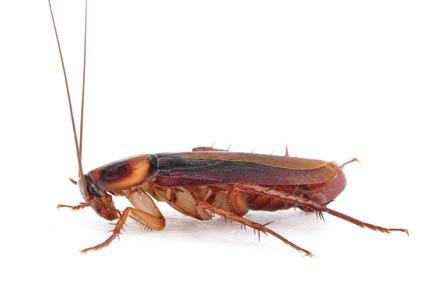There were few things that scared me as a child — darkness and cockroaches were two of them. As I studied biology and later, had my first lessons in evolution, I realised that when cockroaches approach an area, the two factors they check are — how dark is it out there and the presence of other cockroaches. My juvenile fears found some scientific validity.

 There were few things that scared me as a child — darkness and cockroaches were two of them. As I studied biology and later, had my first lessons in evolution, I realised that when cockroaches approach an area, the two factors they check are — how dark is it out there and the presence of other cockroaches. My juvenile fears found some scientific validity.
There were few things that scared me as a child — darkness and cockroaches were two of them. As I studied biology and later, had my first lessons in evolution, I realised that when cockroaches approach an area, the two factors they check are — how dark is it out there and the presence of other cockroaches. My juvenile fears found some scientific validity.
ADVERTISEMENT
Now, you will wonder, in an urban wildlife column, why would I allow cockroaches in from under the door. But these nocturnal scavengers have been sitting tight in the dark recesses of the Earth for well over 350 million years. They have probably, with excitement, watched the Pangaea break and merge into today’s continents; delighted on the arrival of relatives such as termites and mantis; twinkled their compound eyes with 2,000 lenses when dinosaurs arrived and went extinct; and simply chilled through the many ice-ages that have ravaged the planet. And when humans arrived on the scene, they rightfully claimed their position and moved into our homes when we began to behave civilised.

If this was not impressive enough, these hardy and tenacious arthropods proved their true metal during the bombings of Hiroshima and Nagasaki when almost all humans exposed to low grade radiation (6-8gy) died at places far from the epicentre. Shockingly, cockroaches in these Japanese townships survived exposures of nearly 600grays (gray or gy is the unit to measure the level of radiation energy absorption per kilogram). No doubt then that the best character to prove to humans what their plight would be if they didn't care for the Earth, in the animation film, Wall-E was the ubiquitous roach.
While other larger than life creatures, including humans, exhibit a sense of superiority over the Earth, reclusive roaches seek the company of other roaches and leave scent trails for more kin members to join in feasts. Studies have shown that isolated roaches have difficulty digesting food, search for females, and navigate using the social pheromonal communication mechanisms that are prevalent among gregarious roaches.
Being scavengers, cockroaches have played a critical role in our detrital food chain. They consume anything from hair, dead skin cells, glue of postal stamps and book bindings to soiled clothes, dead plants and animals, exposed pet and human food. They leave a foul odour and cause food poisoning. This earns them the reputation of urban household pests.
But what I find funny and endearing about these antennae twirling insects is their fondness for fermented foods such as beer, cheese, bakery products, tea and leather. Roaches often fall prey to flycatchers, fantails, insectivorous bats and even their own kind (cannabalism).
Our moist, dark and unkempt areas in kitchens, septic tanks and parking lots can be favoured congregation grounds for roaches. And shockingly, so are hospitals that offer opportunistic material (patients) to scavenge on. This brings back a ghastly memory of seeing an admitted infant in my uncle’s hospital whose upper lip was eaten away by cockroaches since the parents hadn’t covered it in a net.
Out of 4,600 varieties of cockroaches present across the world, around 30 are associated with human habitats, but only four varieties, viz. American, German, Oriental and Asian, have taken over the entire urban space. Although seemingly obnoxious, Mumbai’s American cockroaches
(Periplaneta americana) are as wild as the leopards in Aarey or dolphins off the Gateway of India. Some varieties such as the Surinam cockroach is a common gardening, urban farming and composting pest. It helps in decomposing herbaceous material, with symbiotic bacteria that help digest the cellulose present in plant cells. Their capacity for extreme sports allows them to stay underwater for over 45 minutes, survive sub-zero temperatures in parts of the Far East and retain consciousness in their head and antenna hours after being decapitated.
Given the survival feat of the roaches, I am filled with amazement. Like certain fanatics have constructed rat temples, I would’ve been tempted to suggest cockroach shrines. And since there is no immediate threat to their survival, the least I can ask for is a cockroach Believe it or Not museum.
Write in to Anand at sproutsonline@gmail.com
 Subscribe today by clicking the link and stay updated with the latest news!" Click here!
Subscribe today by clicking the link and stay updated with the latest news!" Click here!







